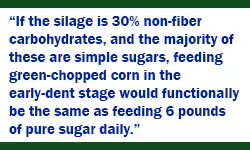
Harvesting and feeding early-chopped corn silage
 By Dr. Michelle Der Bedrosian, Vita Plus forage products and dairy technical specialist
By Dr. Michelle Der Bedrosian, Vita Plus forage products and dairy technical specialistThis spring was marked with significant alfalfa winterkill, severe rainfall and seed shortages, which means forage inventories on many farms are running short. In addition, many producers came into the spring short on alfalfa, which meant they increased their feeding rate of corn silage, leading to the current situation where the demand and price for corn silage is high. As if that wasn’t enough, the extremely wet spring delayed planting, which means the maturity of many crops is all over the board, even within the same field. All of this adds up to many producers considering chopping corn silage early and feeding it right away in an effort to save money.
Many challenges come with chopping corn silage early and feeding green-chopped corn. Overall, it can be a good idea for farms short on inventory, especially when you consider the price and availability of corn silage for purchase.
Ideally, corn silage is harvested at 32% to 35% dry matter (DM), or 65% to 68% moisture. When corn silage is chopped early, it may be wetter. This can bring higher DM losses through seepage, and, if the wetter corn silage is able to be ensiled, the fermentation will tend to be more acetic than usual, which may reduce intakes. One way to combat this is with an upfront fermenter, such as Vita Plus Crop-N-Rich® forage inoculant. It is important to understand that L. buchneri-based inoculants are not recommended for wetter (more than 70% moisture) corn silage because the fermentation is typically acetic enough. Also, if you must chop early and wet, increasing the theoretical length of cut (TLOC) as much as possible can help minimize seepage.
Nitrates can form in crops that have experienced stress, such as drought or heat. Stressed crops should not be fed green, but they should be ensiled; the ensiling process reduces nitrate levels by approximately 50%. Test for nitrates after three to four weeks of ensiling and before feeding to animals. When in doubt of feeding a green-chopped crop, collect five to 10 random plants per field, chop the plants, and test them for nitrates before feeding.
While immature corn does have some benefits, such as higher-than-usual fiber digestibility, it also has some drawbacks. For example, feeding green-chopped corn silage increases wheel traffic on the field due to driving in and out of the field daily, which can lead to soil compaction.
 Green-chopped corn can also have a dramatic effect on the rumen because the starch hasn’t fully formed yet. When corn is chopped early, such as at the early- to mid-dent stage, the carbohydrates in the young kernel may still be a liquid mixture of simple sugars, such as glucose, sucrose, fructose, polysaccharides and starch, which is digested quickly in the rumen.
Green-chopped corn can also have a dramatic effect on the rumen because the starch hasn’t fully formed yet. When corn is chopped early, such as at the early- to mid-dent stage, the carbohydrates in the young kernel may still be a liquid mixture of simple sugars, such as glucose, sucrose, fructose, polysaccharides and starch, which is digested quickly in the rumen.
The best, and most simple, way to learn what stage your kernels are in is to collect a representative sample of ears and cut down the kernels with a knife. If the kernels bleed milk, then they are still immature with a great deal of simple sugars. Chopping and feeding this immature corn significantly increases the risk for acidosis.
To put this in perspective, consider the cow that consumes 20 pounds of corn silage daily. If the silage is 30% non-fiber carbohydrates, and the majority of these are simple sugars, feeding green-chopped corn in the early-dent stage would functionally be the same as feeding 6 pounds of pure sugar daily.
If the immature corn is not fed properly, the bacteria in the rumen may selectively digest the simple sugars and ignore the other nutrients. This can lead to decreased rumen pH and functionality, which can get cows sick and affect components.
Ideally in this situation, a nutritionist will increase dietary buffer, and possibly even urea since urea absorbs acid in the rumen when converting to ammonia.
Your Vita Plus nutritionist can help you maneuver around these challenges to get the most milk per acre possible.
| Category: |
Feed quality and nutrition Forage Foundations Forage harvesting |

